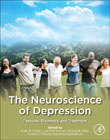
The Neuroscience of Depression: Features, Diagnosis and Treatment
Martin, Colin R.
Hunter, Lan-Anh
Patel, Vinood B.
Preedy, Victor R.
Rajendram, Rajkumar
The Neuroscience of Depression: Features, Diagnosis and Treatment, is a comprehensive reference to the diagnosis and treatment of depression. This book provides readers with the mechanisms of depression reflecting on the interplay between depression and the biological and psychosocial processes. A detailed introduction to various episodes of depression, from PTSD to post-partum depression is provided, followed by a thorough discussion on biomarkers in depression and how to diagnose depression including the Hamilton Depression Rating scale. This book also includes three full sections on treatment options for depression, including pharmacological, behavioral and other novel regimes. The Neuroscience of Depression: Features, Diagnosis and Treatment is the only resource for researchers and practitioners studying, diagnosis and treating of depression. Covers a pharmacological and behavioral treatment optionsFeatures sections on diagnosis and biomarkers of depressionDiscusses depression in children, teens and adultsContains information on comorbidity of physical and mental conditionsIncludes more than 250 illustrations and tables INDICE: I. Depression: Introductory Chapters 1. Clinical staging in depression 2. Neurodevelopmental theory of depression 3. Depression after pregnancy 4. Modeling maternal depression during pregnancy: Rodent models of Major Depressive Disorder with Peripartum Onset 5. Depression in mothers and mental health in children: Impact, risk factors and interventions 6. Depression in college students 7. Depression in disasters and traumatic events 8. Depression and associated Alzheimer s disease 9. Comorbidities of depression and Parkinson's disease 10. Understanding the relationship between depression and alcohol among students 11. Depression in obesity 12. Depression and heart rate variability 13. Neuroinflammation and depression 14. Interlinking antidepressants and the immune system II. Biomarkers and Diagnosis 15. Assessment scoring tools of depression 16. The Beck Depression Inventory: Uses and applications 17. The Hamilton Depression Rating scale: Uses and applications 18. The Patient Health Questionnaire (PHQ) 19. Screening for Antenatal Depression (AND) using self-report questionnaires: Conceptual issues and measurement limitations 20. Edinburgh Postnatal Depression Scale: Description and applicationsJacqueline 21. The Death Depression Scale: Description and applications 22. Depression Anxiety Stress Scales: Features and Applications 23. Arabic version of the two-question Quick Inventory of Depression: Description and applications (QID-2-Ar) 24. Depressive Symptoms and Biomarkers of Cardiovascular Disease 25. Thioredoxin as an antioxidant protein as a marker in depression 26. Methods of neuroimaging in depression: Applications to resting-state functional connectivity 27. Neural markers of depression in MRI III. Pharmacological Treatments for Depression 28. Angiotensin receptor 1 blockade as an antidepression strategy 29. Cannabinoid CB1 receptors and antidepressant effects 30. Agomelatine: profiles and applications to depression 31. Bumetanide and use in depressive states 32. Linking citalopram, serotonin reuptake inhibitors and depressed pregnant women 33. Citalopram and usage in sleep-deprivation-induced depression 34. Monoaminergic System and Antidepressants 35. Duloxetine usage in depression 36. Escitalopram and blonanserin as antidepressant agents linking in neurotrophic mechanisms 37. Ketamine and the role of (2R,6R)-Hydroxynorketamine in depression 38. Linking 5-Hydroxytryptamine, antidepressant actions of (R)-Ketamine and social stress model 39. Mirtazapine: Multi-target strategies for treating substance use disorder and depression IV. Counselling, Psychotherapy and Behavioural Treatments for Depression 40. Mindfulness-based cognitive therapy and depression 41. Online (web based) programs for depression 42. Clay art therapy on emotion regulation: Research, theoretical underpinnings, and treatment mechanisms 43. Solution-focused counselling: and use in postpartum depression 44. Transcranial direct current stimulation (tDCS) combined with cognitive emotional training (CET) as a novel treatment for depression V. Other Aspects of Treatment: Specific Groups, Monitoring and Novel Regimens 45. Putative effects of cannabidiol in depression and synaptic plasticity 46. Tanscutaneous vagus nerve stimulation in depression 47. Exercise for depression as a primary and comorbid with obesity disorder: A narrative 48. Acupressure and depression: a scientific narrative 49. Potential beneficial effects of Bifidobacterium breve A1 on cognitive impairment and psychiatric disorders 50. Coenzyme Q and use in depression 51. Gene expression in Major Depressive Disorder: peripheral and brain based studies 52. Electroconvulsive therapy for depression: effectiveness, cognitive side-effects and mechanisms of action 53. Depression and offspring DNA methylation 54. Other Aspects of Treatment: Specific Groups, Monitoring and Novel Regimens: Treating depression with Theta burst stimulation (TBS)
- ISBN: 978-0-12-817933-8
- Editorial: Academic Press
- Encuadernacion: Rústica
- Páginas: 500
- Fecha Publicación: 01/03/2021
- Nº Volúmenes: 1
- Idioma: Inglés
